
Celebrate ten years of Urban Omnibus and support ten more years of fresh, independent perspectives on citymaking with a donation today!
Celebrate ten years of Urban Omnibus and support ten more years of fresh, independent perspectives on citymaking with a donation today!
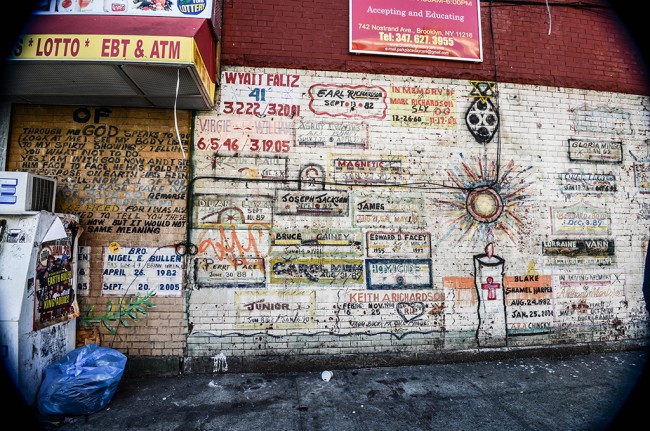
Photo by Tiffany Hagler-Geard
Neighborhoods of contemporary New York are primarily defined by the choices and actions of the people who call them home. They are collages fashioned from layer upon layer of small accretions that we plaster and paint onto our environments. Sometimes, this paint is literal, as is the case with the rich diversity of murals in memoriam found throughout Bedford-Stuyvesant, Brooklyn — public artworks that reflect a particular history of violence, racial prejudice, and, in some cases, the mixture of the two.
These murals fit into a broader lineage of public art in what is one of the city’s iconic historically black communities. Boys & Girls High School houses a renowned collection of pieces by local black artists; the 56-year-old Fulton Art Fair showcases art from the African diaspora in Fulton Park each June (the forerunner of the now-Fort Greene-based Museum of Contemporary African Diasporan Arts, founded in Bed-Stuy in 1999); for the past two years, STooPS has carried on this legacy by showcasing local artists’ work on the neighborhood’s stoops, yards, and streets. The memorial murals are just one part of a much broader tradition.
In the personal essay below, Kristian Sanford, a relatively recent resident, investigates this one aspect of his neighborhood’s visual culture. The memorial murals provide a unique lens into the community and its evolution. Sanford’s difficulty learning more about one mural’s subject and its fading face speak to demographic shifts in a neighborhood that saw a 20% decrease in its black population and a parallel rise in white residents from 2000 to 2010. In touching on many facets of Bed-Stuy — popular, granular, built, and perceived — Sanford’s account embodies how personal and collective memories are embedded in our public spaces and how time simultaneously erodes and enhances them. –J.T.
Shawn continues to be a presence in my life. I see him every day when I walk to and from the subway station, whenever I go out to meet friends or buy milk or walk the dog. It’s been about twenty months since I first noticed him. He always wears a baseball cap and a handsome grin. His friends call him “Mack,” and he has been dead for about ten years.
There are over fifty memorial murals splashed onto the sides of apartment buildings, bodegas, alleyways, and playgrounds in Bedford-Stuyvesant, Brooklyn. Shawn rests near my apartment on Marcy Avenue. Sheldon is remembered on a deli at Tompkins and Gates Avenues. Jose adorns a sliver of Myrtle. Mathew at Throop and Greene. Juice at Lafayette and Franklin. A hardware store on the corner of Halsey Street and Tompkins Avenue eulogizes thirty people, from departed local loved ones to cultural champions Dr. Martin Luther King, Jr. and Jackie Robinson.
One chilly afternoon, I was walking the dog past Shawn’s mural and found two candles sitting on the sidewalk below the painting. One was lit, one was unlit and knocked on its side, clumsily rolling around in half-circles. I propped it back up, lit it, looked up at the memorial and wondered if I should have touched the candle. This is someone’s someone, I realized. This is very real. On the top right corner of the mural was a phone number below the words “FLAIR DEEDEE.” Thinking this must be the artist, I wrote down the number. The dog whined; we went home.
Calls to Flair Deedee went unanswered. I asked a woman who lives in the building next door if she knew the man on the wall and she looked at me like I was crazy. The men at the corner store across the street had no idea: “We just opened in this neighborhood a year ago; we know no one on this wall.” I got a cup of coffee so that I wouldn’t feel guilty for wasting their time. I went home to scour the Internet and found nothing about Shawn. The coffee was terrible.
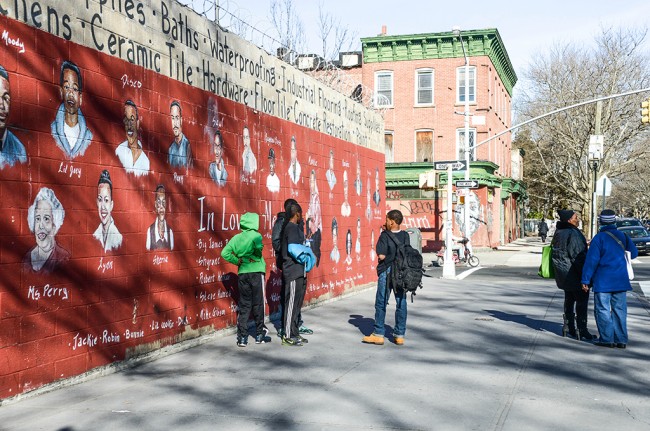
Mural at Halsey Street and Tompkins Avenue | Photo by Tiffany Hagler-Geard
A broader web search led me to an article written by a cultural researcher living in Bed-Stuy. Dr. Elke Weesjes recently put together an exhibit showcasing the history of Bed-Stuy’s murals — from graffiti to commissioned pieces — with commissioned photographs by Tiffany Hagler-Geard at the neighborhood’s Bedford Library. Her exhibit explores the history of the area’s public art, touching on its inception during the post-Civil Rights era in New York City and culminating in a discussion of today’s commissioned murals and how changing demographics have influenced both their growth and decay. In the exhibit’s accompanying article, she writes:
The subject matter of many murals is complex. … These works of art are also temporary. Many have disappeared, been whitewashed, or demolished along with the buildings they were painted on. Faded murals are especially symbolic, silently echoing a community struggle people are no longer aware of or that has since been overcome.
While her article is mostly unrelated to what I really want to know, the notion of a temporary memorial resonates deeply with me. Shawn’s face is hardly legible at this point. It is likely he’ll be unrecognizable in a year or two. The building rests, unbothered, waiting to be repurposed. And then what? Who or what will take Shawn’s place? Will there be another mural? Will there be any more candles?
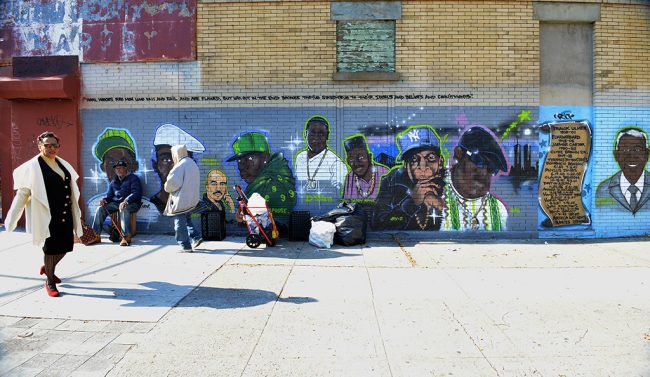
Justice Corps Mural (2009), Fulton Street and Albany Avenue. The mural is part of the Icons Campaign, an initiative of the Bedford Stuyvesant Restoration Corporation, which celebrates the neighborhood’s rich heritage and economic resurgence. | Photo by Tiffany Hagler-Geard
My search began by looking beyond these particular questions to the complex history of the neighborhood itself. Bed-Stuy’s murals have grown within and alongside the neighborhood; what was once a railroad hub on the edge of the blossoming city of Brooklyn in the mid-1800s had by the late 19th century grown into a working and middle-class community supported by those who worked in downtown Manhattan. By the 1960s, the neighborhood was a hotbed of racial tension: the gang riots of 1961 and race riots of 1964 placed a spotlight on the country’s bigger picture issues regarding race.
As the civil rights movement’s influence spread across the country, it also added a new dynamic to the community’s public art presence. New York State senator Robert F. Kennedy, the political sponsor of many initiatives during President Johnson’s War on Poverty, put particular weight behind the Special Impact Program, an amendment to the Economic Opportunity Act of 1964. It specifically targeted Bed-Stuy and helped establish some of its most prominent community organizations, including the Bedford Stuyvesant Restoration Corporation. This organization implemented innovative programs in housing, economic development, and arts and culture that were used as a model for other troubled American cities. Public art was seen as an important part of the strategy to fight poverty and its effects on neighborhoods.
While doing research a few nights later, I found a Google Map dedicated entirely to the location and details of memorial murals in the neighborhood. It is extensive and morbid. I began to explore. I found Shawn, but the map contains no information regarding his mural that I didn’t already know.
After an hour, I’d clicked and read about every location on the map.
An especially powerful piece stood out on the map: on Verona Place, sandwiched between Fulton and Macon Streets, is a faded fifteen-foot-wide, haunting, green cacophony of faces, flowers, and children playing instruments. There are three names and ages and the word “murdered” after each one. I took note of each name. The mural is worn down to almost nothing in large swaths. Dr. Weesjes’s words came back to me: These works of art are also temporary. Faded murals are especially symbolic.
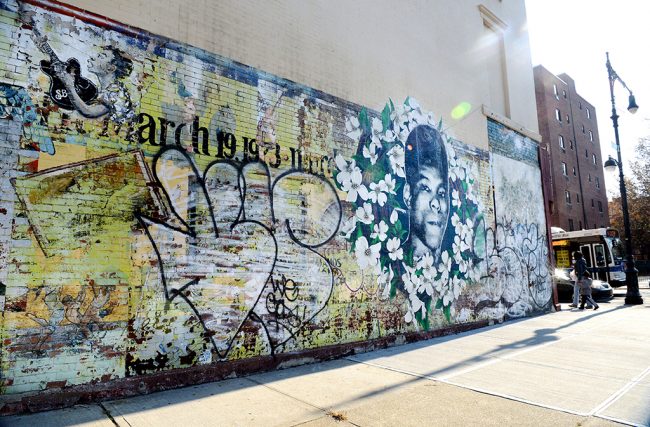
Memorial to Yusuf Hawkins by Floyd Sapp (1989) and retouched by Gabriel Specter (2011), Fulton Street and Verona Place | Photo by Tiffany Hagler-Geard
The first and most prominent name and face on the wall is that of Yusuf Hawkins, born March 19, 1973, killed August 23rd, 1989. A black sixteen-year-old, he was beaten to death in Bensonhurst by a crowd of white men. Seven carried baseball bats, and one carried a handgun that he used to shoot Yusuf in the chest two times. His death inspired a citywide march for racial equality. His story is the most well known. His mural is in the best condition of the three on this wall; street artist Gabriel Specter retouched community artist Floyd Sapp’s original artwork in 2011.
The name highest on the wall is that of Gavin Cato, born November 24, 1983, killed August 19, 1991. Gavin, a seven-year-old child of Guyanese immigrants, was fixing his bicycle on President Street when an out-of-control car struck him. The car’s driver, a Jewish man who was driving as part of a three-car motorcade of Rabbi Menachem Mendel Schneerson, was dragged out of his wrecked car and beaten as bystanders tried to pry Gavin and his cousin out from under the wreckage. Gavin’s cousin, while severely injured, survived the accident. The incident sparked the Crown Heights Riot, which led to at least two murders and contributed to David Dinkins’s loss in the 1993 New York City mayoral election.
The racial tension that runs through both stories emerged as a recurring theme over the course of my research. I kept looking for more information about the wall and its subjects, and I moved on to the next name.
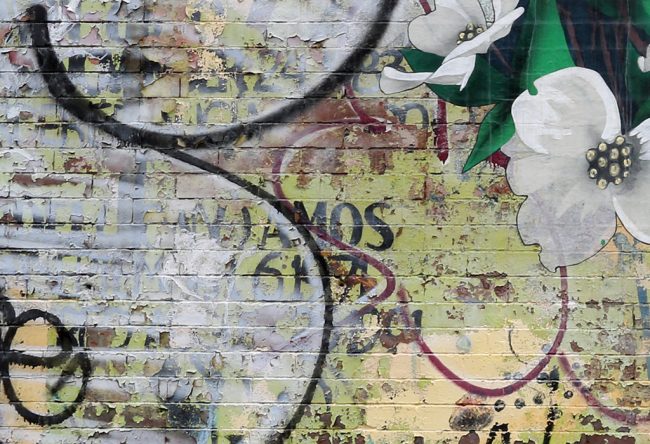
Detail of Yusuf Hawkins mural at Fulton Street and Verona Place showing the fading name of Andel Anthony Amos in 2013. This section of the mural is now painted over. | Photo by Timothy Krause
The final name is that of Andel Anthony Amos, born September 6, 1971, killed August 25, 1991. Police, responding to reports of a shooting in the area, found Andel with a gun. Reports say Andel dropped his gun and fled the scene, and that’s when an officer emptied his pistol into Andel’s back. A grand jury eventually found the officer not guilty of any criminal conduct and this ruling, coming so soon after the death of Gavin Cato, led to two more days of neighborhood riots.
And there are dozens more, their subjects waiting to be discovered, remembered. As I dug deeper I noticed patterns of violence, patterns of age, patterns of race and of gender. But I also noticed a different, more striking pattern: many of those who died are inextricably linked to one another in some way, obviously by locale, but also by acquaintance, concurrence, or sheer coincidence.
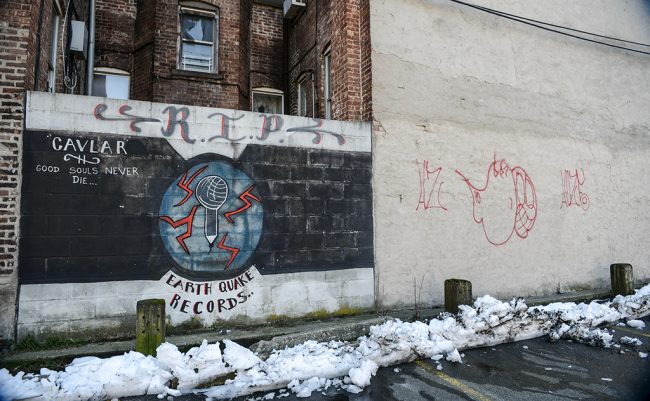
Memorial to Cavlar, Lewis Avenue and Gates Avenue | Photo by Tiffany Hagler-Geard
For example: Leval Lyde, an up-and-coming rapper known as Cavlar and the father of three, was gunned down on Fulton Street; he is muralized at Lewis and Gates. A ten-year-old, Akeem Saluki, is pictured at Macon and Malcolm X. He was hit by a car while playing ball in the street. His mural was drawn by artist and actor Gano Grills, who is credited with creating logos for members of the rap group the Wu-Tang Clan. Deceased member of the Wu-Tang Clan Ol’ Dirty Bastard is memorialized less than a mile away on Putnam and Franklin. This community is close-knit; these stories are interwoven. Peeling back one layer reveals another, and another, and once you discover one connection, it is difficult not to take notice of the rest.
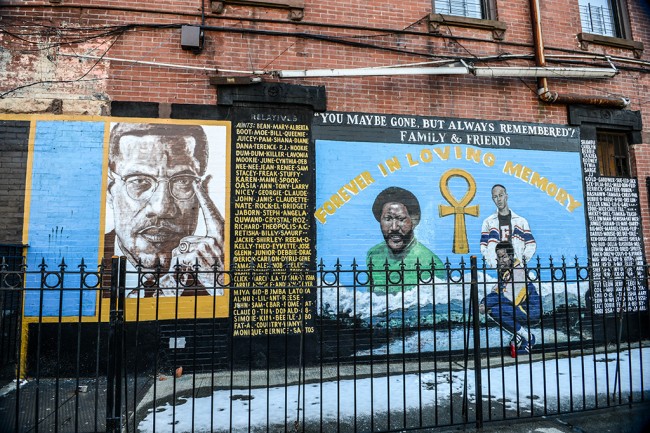
Madison Street and Marcus Garvey Boulevard | Photo by Tiffany Hagler-Geard
Weeks breeze by and I’ve exhausted almost every option for learning more about Shawn and his mural. I’m truly at a loss as to how he died or what he did to be remembered on this wall. Dr. Weesjes kindly provided me with links and contacts but nothing leads to Shawn. I’ve sent emails to local muralists, to curators, to building owners, and I’ve received nothing. Local grocery owner and longtime neighborhood resident George Collado offered his help; after contacting two nearby acquaintances we found no new information. And then, one wet morning on my walk to work, I noticed that the typically locked and gated front door of 599 Marcy was open. Fat raindrops slapped the ground as I opened the door to a decrepit waiting room to find a woman looking at me from behind a wall of plexiglass, seemingly confused by my presence.
“May I help you?”
I stumbled over my words a bit while introducing myself. “Um, yes. Is this a dentist’s office?” The only legible words on the weatherworn sign atop Shawn’s mural are for a dental clinic.
“No,” she said. “This is a general medical clinic,” and she pointed to the doctor’s name on the wall behind her. Next to that name hangs a large handwritten sign that reads, “WE ARE MOVING.” The date is set for the end of May, about three weeks from the day I’m there.
“Do you know the owners?” I asked.
“Nope. They aren’t around here.”
“Do you know anything about the man on the mural outside?”
“He was killed or something. Other than that we don’t know. Have you tried talking to neighbors?”
“I have. I see from that sign you’re moving — why?”
“I heard the owners are knocking this place down and building something else.”
I thanked her for her time and walked outside. I had a hundred questions. I had no more questions.
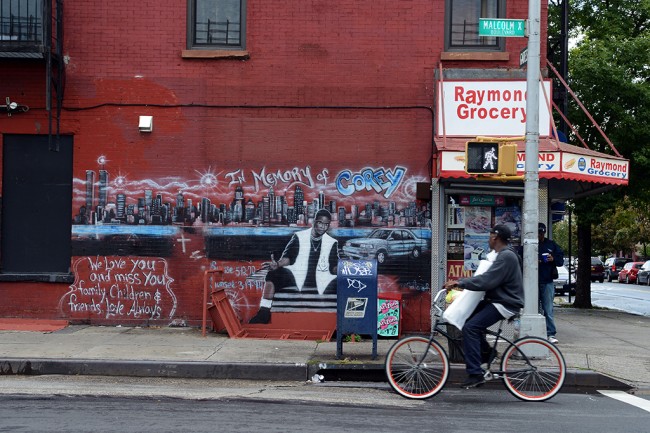
Gates Avenue and Malcolm X Boulevard | Photo by Tiffany Hagler-Geard
The exchange, telling of the nature of these urban gravestones, left me with a bittersweet lack of closure, a sense of defeat. Shawn’s mural inspired me to learn about these memorials: why they were made, who they were made for, the stories inside. And his story appears to be all but lost, wearing thinner by the day, swallowed by the passage of time.
A major contributor to these changes is likely the rapidly changing demographics of the neighborhood, which could put to rest the idea of Mural as Memorial. Just recently the New York Times took notice of Bed-Stuy’s “new look.” The piece explores the radical changes the neighborhood has seen in the past few decades, from its real estate to racial makeup, from its architecture to its summer block parties. In the article, local broker Morgan Munsey says, “You’ve got the most unexpected, diverse people moving into the neighborhood now. I’m getting a lot of Europeans, and actually lots of Germans.” New residents mean new buildings, new community issues, and potentially newly commissioned public art pieces. Things have changed. Things are changing. Things will continue to change. Bed-Stuy is no exception.
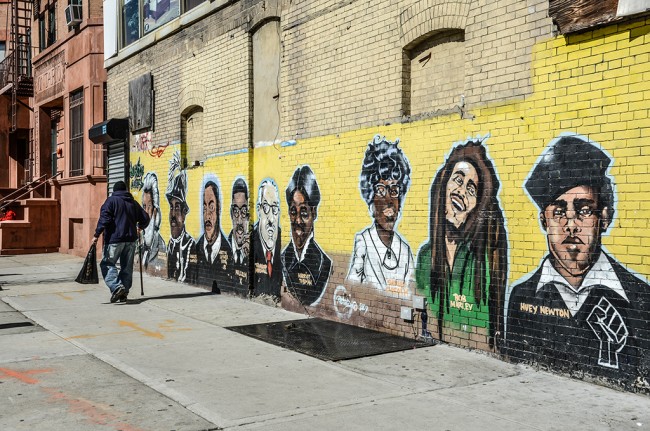
Justice Corps Mural (2009), Nostrand Avenue and Herkimer Street | Photo by Tiffany Hagler-Geard
Bedford-Stuyvesant moves on. Over 136,000 people call the neighborhood home. Its demographics change drastically from decade to decade. In ten years it will be thoroughly different than it is today, and that’s not a good thing, and it’s not a bad thing — it just is. Buildings are razed; new buildings sprout. These pieces of art rise and fall with them.
While the neighborhood inevitably transforms, there will continue to be stories like Shawn’s strewn across and held within the walls of Bedford-Stuyvesant. These collected memories will live on over the generations, on brick walls or on the sides of small grocery stores or in the hearts of loved ones. They’ll tell gloomy tales of death while celebrating life in vivid colors and vibrant designs; they are eye-catching and they are delightful in the saddest, most absurd way. The city is a living graveyard, ever changing.
About a year has passed since I first took interest in Shawn’s mural. After researching and writing about it, I walked by at 11:00am on a bright Saturday morning in September. The candles below Shawn’s mural flickered in the breeze, their incandescence quelled by the morning sunlight, and I stopped to look. “You should take a photo of this,” my girlfriend told me, “so you can remember it forever.”
The views expressed here are those of the authors only and do not reflect the position of The Architectural League of New York.
Comments